EXECUTIVE SUMMARY
The lines between science, medicine and beauty are blurring. Consumers are increasingly seeking cosmetic products with higher efficacy, and cosmetics containing pharmaceutical-inspired ingredients are gaining popularity, as they are perceived to offer better results by delivering nutrients that are necessary for healthy skin.
The global market for cosmetic products offering drug-like benefits is estimated by market research firm RNCOS Business Consultancy Services to grow at a CAGR of about 9% during 2014–2020 to reach $61 billion in 2020, making it one of the fastest-growing segments in the personal care industry. The major driving forces behind this growth are the aging population in developed countries and continuous innovation by beauty brands.
Clinically inspired ingredients such as antioxidants, retinoids, peptides, depigmentation agents and growth factors are claimed to address a variety of skin conditions—from dryness and dehydration, to unwanted pigmentation, to dullness, to the effects of aging. They are thus more easily marketed to consumers, and cosmetics makers can demand premium prices for beauty products containing these advanced ingredients. In response to this trend, beauty companies are making huge investments in biotechnology in order to stay ahead of the game.
[caption id="attachment_90797" align="aligncenter" width="373"]
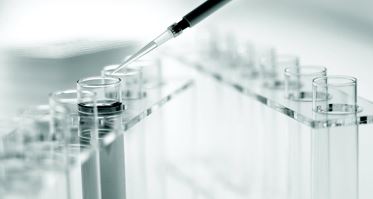 Source: Esteé Lauder Companies
Source: Esteé Lauder Companies[/caption]
The adoption of pharmaceutical-style benefits is expanding into other beauty categories, too, such as haircare and fragrance. Haircare brands are also making use of clinically inspired ingredients to offer solutions for hair loss, thinning hair, and damage caused by styling and pollution. Meanwhile, there has been a breakthrough in fragrance: scientists have developed a perfume delivery system that is effective even when the wearer perspires.
In addition, thanks to advances in technology, cosmetics makers are now able to offer customized products that are based on DNA testing. Beauty brands are also applying advanced stem cell technologies in the development of antiaging cosmeceuticals. Although the true efficacy of these new products remains to be seen, demand for innovative products continues to grow, as consumers are more informed and more scientifically literate than they were a few decades ago.
[caption id="attachment_90798" align="aligncenter" width="367"]
 Source: elle.com
Source: elle.com[/caption]
BIOTECHNOLOGY INVADES COSMETICS
The lines between science, medicine and beauty are blurring, as major cosmetics companies have begun to use biotech materials, genetic profiling, and stem cell–based products and therapies in product development. Specifically, biotechnology has been a major source of innovation for cosmetics and skincare companies over the past decade. One of the most famous biotechnology products is botulinum toxin, which is commonly known by its commercial name, Botox. It is made from the bacteria
Clostridium botulinum, which can cause the fatal disease botulism, and it improves the appearance of wrinkles by temporarily paralyzing nerve cells.
Huge Markets at Stake
There are huge markets driving the convergence between science, medicine and beauty. The global healthcare market is approximately $7.6 trillion, the global medicine market more than $1 trillion, and the global beauty market is nearly $300 billion. Adding these figures together results in a combined $9 trillion market.
[caption id="attachment_90799" align="aligncenter" width="418"]
 Source: Euromonitor/Forbes/IMS Health/The Business Research Company
Source: Euromonitor/Forbes/IMS Health/The Business Research Company[/caption]
Probiotic and Biomimetic Technology in Beauty
Probiotics are a newer trend in the beauty industry. While they are usually used to help maintain good digestive health, now they are being tested for use in skincare. Dermatologists are encouraged by early research indicating that probiotics may offer a protective shield to the skin. A recently launched skincare brand called TULA makes use of patented probiotic technology to protect and revitalize skin.
“Biomimetics” (a combination of “bio” and “mimic”) refers to imitating the biology of natural living organisms in processes, models or compounds, and research in this field has the potential to take skincare to new levels of effectiveness and results. Cosmetics makers are using this technology to develop ingredients that mimic biological functions in the body. For instance, many substances naturally present in the human body can help the body repair itself. The development of ingredients that are based on these substances, or that can mimic them, could have huge ramifications for the skincare and beauty industries. Accordingly, scientists are not just mixing ingredients into a cream, but also formulating them in a way that imitates the biological conditions of young, healthy skin.
As demand for natural cosmetics is growing, biomimetics opens up a myriad of product development opportunities for beauty brands. Lipotec, a manufacturer of active ingredients for cosmetics, developed a compound called Hyadisine marine ingredient, a biomimetic of hyaluronic acid. The ingredient confers skin benefits such as moisturization and wrinkle reduction. Croda, a British specialty chemicals company, launched Kerestore 2.0 as a biomimetic of keratin proteins found in human hair that provide targeted repair to damaged areas in hair follicles.
3D Human Skin Bioprinting: The Next Big Thing in Beauty?
Scientists have been working on bioprinting human skin for some time, but its application in the beauty industry remains at the cutting edge. In 2015, L’Oréal announced that it would collaborate with US biotech company Organovo to develop 3D-printed skin tissue for cosmetic testing as well as other areas of advanced research. This will be the first application of the technology in the beauty industry, and animal-free cosmetic testing could be possible in the near future. Procter & Gamble has also gotten into the game, recently reporting that it would explore the possibilities of 3D bioprinting, which could provide a quicker and cheaper way to test products’ safety and efficacy.
Cosmetics Makers Are Investing Aggressively in Biotechnology Companies
Both brand owners and ingredient makers are investing heavily in product innovation, adopting new technologies and, in some cases, partnering with or even acquiring biotechnology companies in order to stay ahead of the innovation game. For instance, Japanese skincare brand Shiseido has been working with Vancouver-based biopharmaceutical company RepliCel to bring to the Asian market hair-loss treatments based on regenerative medicine. And Fujifilm, which specializes in regenerative medicine and functional skincare, acquired biotechnology company Cellular Dynamics International (CDI) for $307 million last year. CDI manufactures multiple high-quality and fully functioning human cell types in industrial quantities. After the acquisition, Fujifilm further strengthened its presence in the area of regenerative medicine.
Thriving Cosmeceuticals Market
“Cosmeceutical” (a fusion of “cosmetic” and “pharmaceutical”) refers to a cosmetic product with biologically active ingredients that offer medical or drug-like benefits. With topical application, such substances can penetrate the deeper, subdermal layers of the skin and deliver nutrients necessary for healthy skin. Consumers often associate the clinically inspired ingredients in cosmeceuticals with efficacy, and they are willing to pay a premium price for these products. Although skepticism abounds regarding the clinical efficacy and scientific basis for some popular product claims, strong consumer demand has made cosmeceuticals the fastest-growing segment of the global cosmetics industry.
The Freedonia Group pegged US demand for cosmeceuticals at $8.5 billion in 2015. Market research firm RNCOS projects that the global market for cosmeceuticals will grow at a CAGR of about 9% during 2014–2020 and reach $61 billion in 2020.
[caption id="attachment_90800" align="aligncenter" width="363"]
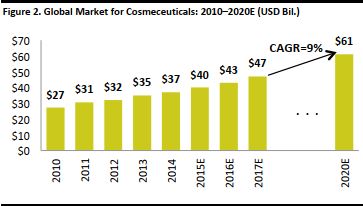 Source: RNCOS Business Consultancy Services
Source: RNCOS Business Consultancy Services[/caption]
RNCOS further estimates that the $61 billion global market for cosmeceuticals in 2017 will break down as follows:
[caption id="attachment_90801" align="aligncenter" width="354"]
 Source: RNCOS Business Consultancy Services
Source: RNCOS Business Consultancy Services[/caption]
As mentioned earlier, the healthy growth in cosmeceuticals is mainly being driven by an aging population across the globe and by product innovation by cosmetics makers. Antiaging products are in particularly high demand.
As cosmeceuticals are not regulated by the US Food and Drug Administration (FDA), cosmetics manufacturers can avoid the hassle of time-consuming and expensive regulatory processes for obtaining approval for these products. At the same time, they can demand premium prices for cosmeceuticals because consumer demand for their additional health and therapeutic benefits is strong.
At the same time, biotechnology companies are increasingly licensing methods for repairing DNA and healing wounds to the cosmetics industry. One major benefit for the biotech companies is that cosmetic products do not have to undergo clinical trials, as drugs do, allowing them to develop innovative products more quickly and cheaply.
[caption id="attachment_90802" align="aligncenter" width="332"]
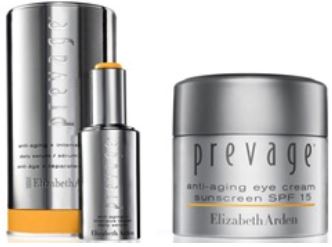 Source: primped.com/ulta.com
Source: primped.com/ulta.com[/caption]
Topical Biologically Active Ingredients
Some biologically active ingredients, including antioxidants, retinoids and peptides, offer therapeutic or healing properties that help the products that contain them become big sellers in the antiaging market. Antioxidants are an essential ingredient in cosmeceuticals. One of the most potent antioxidants is idebenone, which was originally used as a medication to prevent memory loss. This antioxidant can help protect skin from free radicals caused by the sun and pollution. Idebenone now can be found in a variety of Elizabeth Arden’s antiaging products, including the top-selling Prevage Anti-Aging Night Cream and other products in the Prevage line.
Other topical ingredients that were originally developed as a medication are tretinoin (a form of vitamin A) and retinoid, which is a derivative of vitamin A. Retinoid is approved by the FDA, and dermatologists have been using it for years for treatment of skin problems such as acne and hyperpigmentation. Retinoid is now being used widely as an active ingredient in many skincare products and is advertised as being able to accelerate cell turnover and stimulate collagen production, both of which rejuvenate skin.
Among the most exciting developments in the cosmeceuticals market are antiaging products containing peptides. Composed of long-chain amino acids, peptides are the building blocks of proteins. Most peptides function as moisture-binding agents and most of them have cell-communicating abilities to help skin repair itself.
[caption id="attachment_90803" align="aligncenter" width="372"]
 Source: skincare.net
Source: skincare.net[/caption]
Studies on peptides such as Argireline (made by Lipotec) show that they can produce a mild, Botox-like effect to relax facial wrinkles. Newer peptide formulations can act like growth factors, accelerating skin cell turnover to a rate similar to that of young skin. One product that contains these peptides is Olay’s Regenerist Micro-Sculpting Cream moisturizer. It is advertised as penetrating deep to speed up surface cell regeneration and restore skin’s youthful appearance.
[caption id="attachment_90804" align="aligncenter" width="370"]
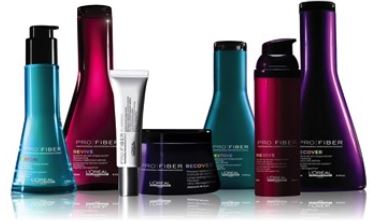 Source: notey.com
Source: notey.com[/caption]
Hair Cosmeceuticals and a Breakthrough in Fragrance
Cosmeceuticals have traditionally been associated with the skincare space, but both haircare and fragrance brands are also adopting pharmaceutical-inspired approaches to product development. Hairceuticals (i.e., hair cosmeceuticals) have been gaining ground in recent years. These products use clinically inspired ingredients to offer solutions for hair loss, thinning hair, dry or oily hair, and hair damage caused by styling and pollution. Consumers are increasingly concerned about the health of their hair, and they are looking for products that can improve both hair health and appearance. Many haircare brands are tapping into this opportunity by offering more complex and medically inspired haircare products.
High-end haircare brand Julien Farel is one of the brands innovating in this area. Farel claims that its Magnifique Fortifying Serum is the first antiaging elixir for hair that is designed to delay the graying process and restore hair’s youthful texture and appearance.
Pureology, a specialist in caring for color-treated hair, incorporates clinically inspired ingredients such as proteins, amino acids and lipid complexes into its Strength Cure Restorative Masque to boost hair strength and reduce breakage.
L’Oréal Professionnel has launched the Pro Fiber line, which is the first repairing treatment that offers long-lasting haircare that can be reactivated again and again. It uses a silicone compound to penetrate deep into hair and repair the cortex while also reinforcing and strengthening its structure. In 2012, haircare brand Herra introduced Herra Protect Hair Perfume, which the company claims protects hair from UV damage and pollution while also adding fragrances to it.
As for innovation in fragrance, scientists from Queen’s University Belfast have created an ionic liquid that releases fragrance when it comes into contact with moisture. Perfume containing this ionic liquid can effectively overcome odors caused by perspiration. This breakthrough presents great commercial potential for use in fragrance and cosmetic products in the future.
CUSTOMIZATION OF BEAUTY PRODUCTS USING NEW TECHNOLOGY
Genetic Testing for Customized Treatments
Beauty industry research has focused heavily on innovation and responding to consumer demand for customized products that improve the appearance of skin. Advances in genetic technology now enable many beauty products to be customized based on different human genes, tastes and preferences.
Genetic profiling, for example, allows beauty companies to offer tailor-made beauty products. Skincare startup GeneU claims to have the world’s first in-store DNA test for personalized skincare. GeneU launched a skincare lab in London that offers skin profiles for customers in 30 minutes; these detail collagen breakdown, antioxidant protection levels and skin reaction to free radicals. Based on an individual’s skin profile, GeneU can offer personalized antiaging products with specific combinations and concentrations of ingredients.
Another company working to apply genetic technology to beauty products is KOSÉ. The company is conducting research on the use of induced pluripotent stem (iPS) cells to rejuvenate human skin. With this technology, human skin cells would be extracted to create tailor-made iPS cells. While the research is still at an early stage, KOSÉ aims to develop customized skin-rejuvenating products in the near future.
[caption id="attachment_90805" align="aligncenter" width="368"]
 Source: cnn.com
Source: cnn.com[/caption]
Personalization Based on Taste or Feeling
While some beauty brands use genetics as the basis for product customization, others tailor products to individuals’ tastes or preferences. For example, British brand Concoction allows customers to personalize shampoo by mixing ingredients just as they might a cocktail: different volumes and types of superserum are mixed into the base fragrance to create a unique shampoo. And luxury brand Clarins sells a self-tanning product called Radiance-Plus Golden Glow Booster that users can customize by dropping varying amounts of it into their daily moisturizer.
Medical Technology in Beauty
The beauty industry has adopted a number of medical technologies and devices over the years. For instance, injections of various beauty products can now be delivered deep into the skin via microneedles. These are constructed from and deliver medicine using a type of acid, and have been used by Japanese beauty brands Shiseido and MTG. The beauty-essence liquid and eye patches developed by Bigendo also deliver wrinkle-targeting ingredients deep into the skin.
In recent years, “stem cells” has become a buzzword in the skincare world. Makers of stem cell–based beauty products claim that they help people stay young. Some companies are developing products with plant stem cells, which either help protect human skin stem cells from damage or stimulate skin’s own stem cells when applied topically.
[caption id="attachment_90806" align="aligncenter" width="357"]
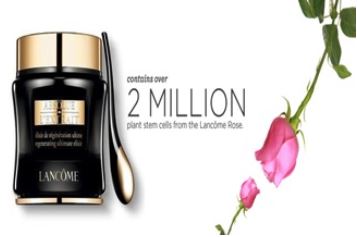 Source: cnn.com
Source: cnn.com[/caption]
The use of stem cell technology is controversial and still in its infancy, but it is growing rapidly. L’Oréal is the cosmetics industry pioneer in terms of research on stem cells in the skin and hair. It developed a revolutionary stem cell treatment for baldness called Kérastase Densifique. High-end beauty brand Lancôme created Absolue L’Extrait, which contains over 2 million plant stem cells extracted from the Lancôme Rose. The product is advertised as enhancing skin’s regenerative potential. And Estée Lauder introduced Re-Nutriv, a skin cream enriched with white tuberose stem cells that is designed to treat skin dullness, uneven skin tone and any signs of aging.
Using iPS cells, it is now possible to reduce the apparent age of skin by decades. KOSÉ, discussed above, is at the forefront of this field, and its products that use stem cell technology are expected to be out on the market within five years.
CONCLUSION
Medical science and biotechnology are playing increasingly greater roles in the beauty industry due to growing consumer demand for advanced cosmetic formulations and efficacious ingredients. The boundaries between cosmetics and pharmaceuticals are therefore blurring. Cosmeceuticals have emerged as the result of science, medicine and beauty converging. Although there is little convincing evidence for many claims of clinical efficacy, cosmeceuticals are irresistible to many consumers, as they offer the promise of maintaining a beautiful and youthful appearance.
Beauty brands and biotechnology and pharmaceutical companies are making huge investments in new technology to drive product innovations. With the heightened investment in scientific research and new technology, “defeating” skin aging with beauty products will become increasingly possible. Biomimetics, 3D bioprinting, and genetic and stem cell technologies will all be areas of research focus in the beauty industry in the future. All of these developments should ultimately benefit consumers by resulting in the next generation of safer and more efficacious products.

 Source: Esteé Lauder Companies[/caption]
The adoption of pharmaceutical-style benefits is expanding into other beauty categories, too, such as haircare and fragrance. Haircare brands are also making use of clinically inspired ingredients to offer solutions for hair loss, thinning hair, and damage caused by styling and pollution. Meanwhile, there has been a breakthrough in fragrance: scientists have developed a perfume delivery system that is effective even when the wearer perspires.
In addition, thanks to advances in technology, cosmetics makers are now able to offer customized products that are based on DNA testing. Beauty brands are also applying advanced stem cell technologies in the development of antiaging cosmeceuticals. Although the true efficacy of these new products remains to be seen, demand for innovative products continues to grow, as consumers are more informed and more scientifically literate than they were a few decades ago.
[caption id="attachment_90798" align="aligncenter" width="367"]
Source: Esteé Lauder Companies[/caption]
The adoption of pharmaceutical-style benefits is expanding into other beauty categories, too, such as haircare and fragrance. Haircare brands are also making use of clinically inspired ingredients to offer solutions for hair loss, thinning hair, and damage caused by styling and pollution. Meanwhile, there has been a breakthrough in fragrance: scientists have developed a perfume delivery system that is effective even when the wearer perspires.
In addition, thanks to advances in technology, cosmetics makers are now able to offer customized products that are based on DNA testing. Beauty brands are also applying advanced stem cell technologies in the development of antiaging cosmeceuticals. Although the true efficacy of these new products remains to be seen, demand for innovative products continues to grow, as consumers are more informed and more scientifically literate than they were a few decades ago.
[caption id="attachment_90798" align="aligncenter" width="367"] Source: elle.com[/caption]
Source: elle.com[/caption]
 Source: Euromonitor/Forbes/IMS Health/The Business Research Company[/caption]
Source: Euromonitor/Forbes/IMS Health/The Business Research Company[/caption]
 Source: RNCOS Business Consultancy Services[/caption]
RNCOS further estimates that the $61 billion global market for cosmeceuticals in 2017 will break down as follows:
[caption id="attachment_90801" align="aligncenter" width="354"]
Source: RNCOS Business Consultancy Services[/caption]
RNCOS further estimates that the $61 billion global market for cosmeceuticals in 2017 will break down as follows:
[caption id="attachment_90801" align="aligncenter" width="354"] Source: RNCOS Business Consultancy Services[/caption]
As mentioned earlier, the healthy growth in cosmeceuticals is mainly being driven by an aging population across the globe and by product innovation by cosmetics makers. Antiaging products are in particularly high demand.
As cosmeceuticals are not regulated by the US Food and Drug Administration (FDA), cosmetics manufacturers can avoid the hassle of time-consuming and expensive regulatory processes for obtaining approval for these products. At the same time, they can demand premium prices for cosmeceuticals because consumer demand for their additional health and therapeutic benefits is strong.
At the same time, biotechnology companies are increasingly licensing methods for repairing DNA and healing wounds to the cosmetics industry. One major benefit for the biotech companies is that cosmetic products do not have to undergo clinical trials, as drugs do, allowing them to develop innovative products more quickly and cheaply.
[caption id="attachment_90802" align="aligncenter" width="332"]
Source: RNCOS Business Consultancy Services[/caption]
As mentioned earlier, the healthy growth in cosmeceuticals is mainly being driven by an aging population across the globe and by product innovation by cosmetics makers. Antiaging products are in particularly high demand.
As cosmeceuticals are not regulated by the US Food and Drug Administration (FDA), cosmetics manufacturers can avoid the hassle of time-consuming and expensive regulatory processes for obtaining approval for these products. At the same time, they can demand premium prices for cosmeceuticals because consumer demand for their additional health and therapeutic benefits is strong.
At the same time, biotechnology companies are increasingly licensing methods for repairing DNA and healing wounds to the cosmetics industry. One major benefit for the biotech companies is that cosmetic products do not have to undergo clinical trials, as drugs do, allowing them to develop innovative products more quickly and cheaply.
[caption id="attachment_90802" align="aligncenter" width="332"] Source: primped.com/ulta.com[/caption]
Source: primped.com/ulta.com[/caption]
 Source: skincare.net[/caption]
Studies on peptides such as Argireline (made by Lipotec) show that they can produce a mild, Botox-like effect to relax facial wrinkles. Newer peptide formulations can act like growth factors, accelerating skin cell turnover to a rate similar to that of young skin. One product that contains these peptides is Olay’s Regenerist Micro-Sculpting Cream moisturizer. It is advertised as penetrating deep to speed up surface cell regeneration and restore skin’s youthful appearance.
[caption id="attachment_90804" align="aligncenter" width="370"]
Source: skincare.net[/caption]
Studies on peptides such as Argireline (made by Lipotec) show that they can produce a mild, Botox-like effect to relax facial wrinkles. Newer peptide formulations can act like growth factors, accelerating skin cell turnover to a rate similar to that of young skin. One product that contains these peptides is Olay’s Regenerist Micro-Sculpting Cream moisturizer. It is advertised as penetrating deep to speed up surface cell regeneration and restore skin’s youthful appearance.
[caption id="attachment_90804" align="aligncenter" width="370"] Source: notey.com[/caption]
Source: notey.com[/caption]
 Source: cnn.com[/caption]
Source: cnn.com[/caption]
 Source: cnn.com[/caption]
The use of stem cell technology is controversial and still in its infancy, but it is growing rapidly. L’Oréal is the cosmetics industry pioneer in terms of research on stem cells in the skin and hair. It developed a revolutionary stem cell treatment for baldness called Kérastase Densifique. High-end beauty brand Lancôme created Absolue L’Extrait, which contains over 2 million plant stem cells extracted from the Lancôme Rose. The product is advertised as enhancing skin’s regenerative potential. And Estée Lauder introduced Re-Nutriv, a skin cream enriched with white tuberose stem cells that is designed to treat skin dullness, uneven skin tone and any signs of aging.
Using iPS cells, it is now possible to reduce the apparent age of skin by decades. KOSÉ, discussed above, is at the forefront of this field, and its products that use stem cell technology are expected to be out on the market within five years.
Source: cnn.com[/caption]
The use of stem cell technology is controversial and still in its infancy, but it is growing rapidly. L’Oréal is the cosmetics industry pioneer in terms of research on stem cells in the skin and hair. It developed a revolutionary stem cell treatment for baldness called Kérastase Densifique. High-end beauty brand Lancôme created Absolue L’Extrait, which contains over 2 million plant stem cells extracted from the Lancôme Rose. The product is advertised as enhancing skin’s regenerative potential. And Estée Lauder introduced Re-Nutriv, a skin cream enriched with white tuberose stem cells that is designed to treat skin dullness, uneven skin tone and any signs of aging.
Using iPS cells, it is now possible to reduce the apparent age of skin by decades. KOSÉ, discussed above, is at the forefront of this field, and its products that use stem cell technology are expected to be out on the market within five years.